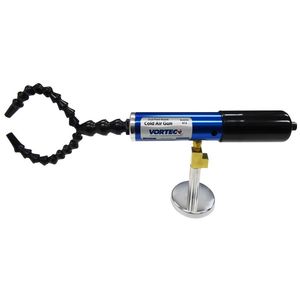
- Hydraulics - Pneumatics
- Pipe, Tube and Fitting
- Cleaning nozzle
- ITW Air Management
Cleaning nozzle 682coolingcold airindustrial


Add to favorites
Compare this product
Characteristics
- Function
- cleaning, cooling
- Fluid
- cold air
- Applications
- industrial
- Flow
6.8 m³/h
(240.14 ft³/h)- Pressure
Max.: 100 psi
Min.: 80 psi
- Media temperature
21 °C
(69.8 °F)
Description
Adaptable Spot Cooling for Machining, Repair Shops and More
Cold Air Guns utilize vortex tube technology and filtered compressed air to generate sub-freezing air as low as -30 deg F (-34 deg C) for various industrial spot cooling applications. With no moving parts to wear out, Cold Air Guns require no electricity at the target, just a compressed air source.
Cold Air Guns are predominantly used for cooling of metal parts, in the machining and repair of metals, plastics, wood, ceramics and other materials. Cold air machining performs better than mist coolants and considerably increases tool life and feed rates on dry machining operations. The efficient cooling from a Cold Air Gun can prevent heat-related parts growth while bettering parts tolerance and surface finish quality.
The Mini Cold Air Gun is engineered for applications where the standard Cold Air Gun is too large to fit, or where compressed air flow is limited. The Mini Cold Air Gun uses only 8 SCFM of compressed air and produces temperatures as low as 0 deg F. The Mini Cold Air Gun is available with a single nozzle or a dual point nozzle for multi-directional cooling.
BENEFITS
Improve dry machining speeds by up to 36%
Prolong tool life by 50%
Alleviates the mess, cost and safety issues of using mist coolants
Lessen waiting or normalization time by cooling parts quicker
Decrease the chances of burning and scorching
Eliminate the need for secondary parts cleaning after machining
Diminish grinding wheel loading caused by overheating
Catalogs
Product Catalogue
68 Pages
Vortec Products CATALOG
32 Pages
Related Searches
- VORTEC spray nozzle
- Liquid atomizing nozzle
- Stainless steel atomizing nozzle
- VORTEC cleaning nozzle
- VORTEC screw-in nozzle
- VORTEC air nozzle
- Brass atomizing nozzle
- VORTEC cooling nozzle
- Atomizing nozzle for the food industry
- Industrial atomizing nozzle
- Chemical nozzle
- Atomizing nozzle for the steel industry
- Air gun
- Compact atomizing nozzle
- VORTEC compressed air nozzle
- NPT atomizing nozzle
- BSP atomizing nozzle
- Pneumatic atomizing nozzle
- Nozzle for pharmaceutical applications
- Nozzle for precision applications
*Prices are pre-tax. They exclude delivery charges and customs duties and do not include additional charges for installation or activation options. Prices are indicative only and may vary by country, with changes to the cost of raw materials and exchange rates.








